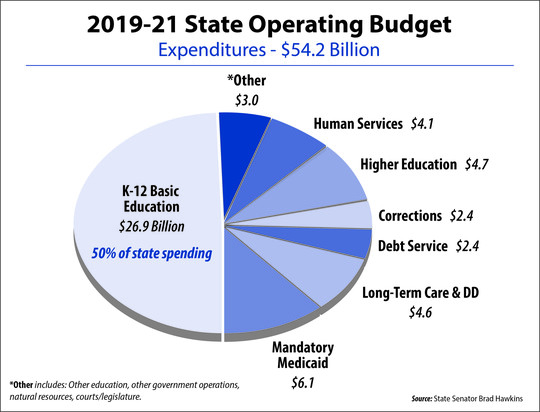March 11, 2021
Dear Friends and Neighbors,
As I shared in a previous email, the major focus of the current legislative session is to develop and approve budgets for the 2021-2023 biennium. Washington state budgets on a two-year basis and develops three budgets: the operating, transportation, and capital budgets. The three budgets will go into effect July 1, 2021, for the 2021-2023 biennium. Budget authorization will end June 30, 2023. Legislators develop the budgets during the legislative session. After the House and Senate approve their respective budget proposals, the two chambers then appoint budget negotiators to discuss the differences between the budgets. All three budgets are very significant, but the operating budget is the largest and receives significant attention.
 The operating budget funds the day-to-day operations of the state, including K-12 education, higher education, human services, natural resources, and other programs. Half of the state expenditures are dedicated to K-12 education and are protected by the State Supreme Court’s McCleary decision.
Operating budget overview
The operating budget funds the day-to-day operations of the state, including early learning, K-12 education, higher education, health and human services, criminal justice, natural resources, and other areas. The Washington state operating budget has grown considerably over the past 15 years and is $54.2 billion for 2019-2021. The budget writers also develop the operating budget based on a four-year outlook, even though the budget cycle is technically two years. Due to past increased spending and reduced revenue from the COVID pandemic, state economists are forecasting a projected budget deficit of nearly $3 billion over the four-year period.
Fortunately, the state has accumulated a healthy reserve account of $2 billion. The official name for our reserve account is the Budget Stabilization Account, often referred to as the “Rainy Day Fund,” and use of it requires legislative approval. Given its approximate $2 billion balance, I believe lawmakers could balance the state operating budget by fully utilizing our reserves and then making some modest and measured reductions in programs. However, many legislators are using the revenue losses from the pandemic in an effort to justify increased revenues. My colleagues and I will probably authorize the use of the Budget Stabilization Account with little disagreement. The big divide will be over whether to choose budget reductions or new taxes to make up the remaining difference.
 The budgets are complicated bills that require significant studying to understand, including how various sources of revenue and expenditures function together. I have a lot to learn about state budgeting but have gained helpful experience each year.
Reviewing expenditures and revenues
In terms of state expenditures, half of the spending (50%) is dedicated to K-12 education with funding allocated to 295 school districts based on student enrollment and established formulas. Other spending includes such things as early learning, higher education, human services, corrections, debt service, long-term care, health care, and natural resources. On the revenue side, our state is one of the few states, currently, without an income tax. Most of the taxes collected include the state portion of the sales, B&O, and state schools tax. The state collects the remaining revenue from other charges and fees. The Washington State Economic and Revenue Forecast Council is responsible for estimating the incoming revenues and provides quarterly reports to the state. The next revenue forecast will be released this month and will help guide operating budget development during the final weeks and months of session. For more information about state budget, click fiscal.wa.gov or A Guide to the Washington State Budget Process.
 The overall revenues for the 2021-23 operating budget are expected to be slightly higher than the previous biennium. Most of the budget revenue is a result of sales taxes and business taxes but other taxes provide smaller sources of revenue.
2021-2023 operating budget proposals
The state normally follows a traditional process for budget development. This process includes the governor releasing his budget proposal prior to the legislative session and the House and Senate developing their own proposals during session. The House and Senate are expected to release their budget proposals this month. Given the size and scope of the operating budget as well as differing philosophies about revenues and spending, it is common for differences to exist among the three budget proposals. Ultimately, all three sides (House, Senate, and Governor) need to agree on the exact same budget document in order for it to be enacted into law. When deep differences exist, sometimes the budget negotiations carry on toward the end of the fiscal year before a final agreed-upon budget is enacted. The current fiscal year ends June 30, 2021, and the new budget begins July 1, 2021. The budget authorizes expenditures for two years: July 1, 2021 – June 30, 2023.
Recent increases in overall state spending
 The state operating budget has grown significantly over the last 10 years. Some of these spending increases – but not all – were in response to the 2012 State Supreme Court’s McCleary decision on K-12 educational funding (resolved in 2018).
Listen to my recent local radio interviews
Each week during the legislative session, I call our local radio stations to participate in live interviews about the latest happenings in the legislative session. If you'd like to hear my most recent interviews, click on these links for KPQ, KOHO, and KOZI.
If you have any questions about the state budget or other issues, contact me anytime.
Thank you for the opportunity to serve as your 12th District state senator.
Sincerely,

Brad Hawkins
State Senator
Brad Hawkins
12th Legislative District
E-mail:
brad.hawkins@leg.wa.gov
Website: senatorbradhawkins.org
107 Newhouse Building
- P.O. Box 40412 | Olympia, WA 98504-0412
(360) 786-7622 or Toll-free: (800) 562-6000
|